Just like their parent moths or butterflies, caterpillars are insects! While these crawling creatures might seem harmless and fascinating to observe, it’s essential to know that some of them are poisonous. In the lush forests, valleys, and even the city parks of Missouri, you can encounter various caterpillars, but recognizing which ones to avoid is crucial.
This article about caterpillars found in Missouri will help you identify these intriguing insects and make you aware of the poisonous ones! No matter how furry and inviting they look, beware!
1. Monarch Caterpillar (Danaus plexippus)

Monarch caterpillars exclusively eat milkweed, which also serves as shelter.
©iStock.com/CathyKeifer
In Missouri, the monarch is one of the most identifiable caterpillars. When they’re in their first growth stage, they might be tiny and colored pale green or a whitish-gray, looking almost see-through. As they grow, they develop distinct stripes of yellow, white, and black, with two black tentacles on the front and back of their bodies. Milkweed is their main source of food and also serves as a shelter.
Both the caterpillar and butterflies are poisonous!
2. Woolly Bear Caterpillar (Pyrrharctia isabella)
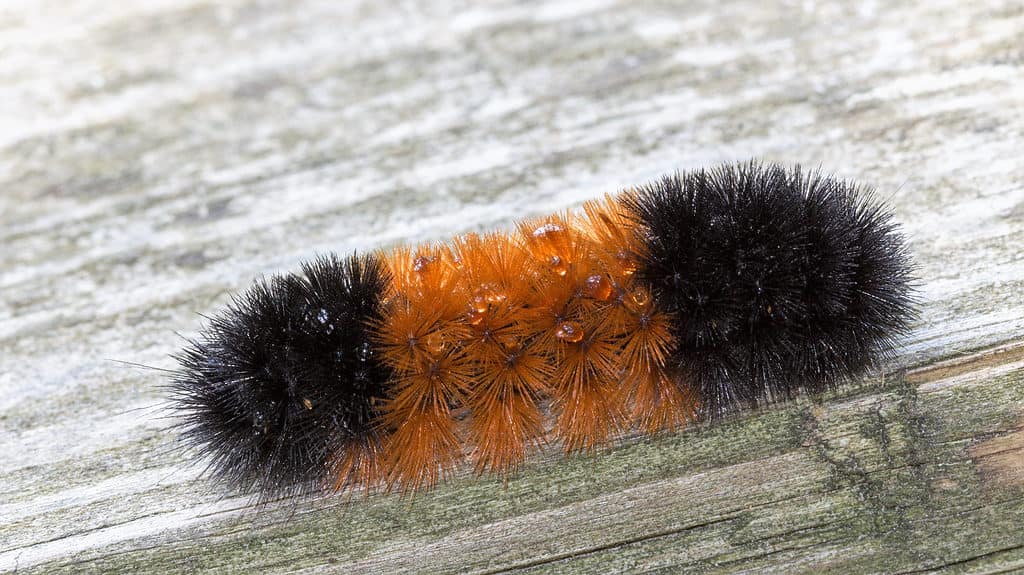
Although they may look dangerous, woolly bear caterpillars are actually harmless and will curl into a ball when frightened.
©Kimberly Boyles/Shutterstock.com
The woolly bear caterpillar is characterized by its 13 unique segments, which can be either a rusty brown or black color. Commonly, the caterpillar is black at both ends with segments of rust in the center, though it can also be primarily black or rust-colored. It’s essential to note that woolly caterpillars that are all black, all white, or yellow are not true woolly bears. These caterpillars typically feed on low-growing wild and herbaceous plants.
Despite their furry look, woolly bears pose no threat to humans as they are not poisonous. They are non-aggressive creatures that tend to curl into a ball, pretending to be dead, when they feel in danger.
3. Viceroy Caterpillar (Limenitis archippus)
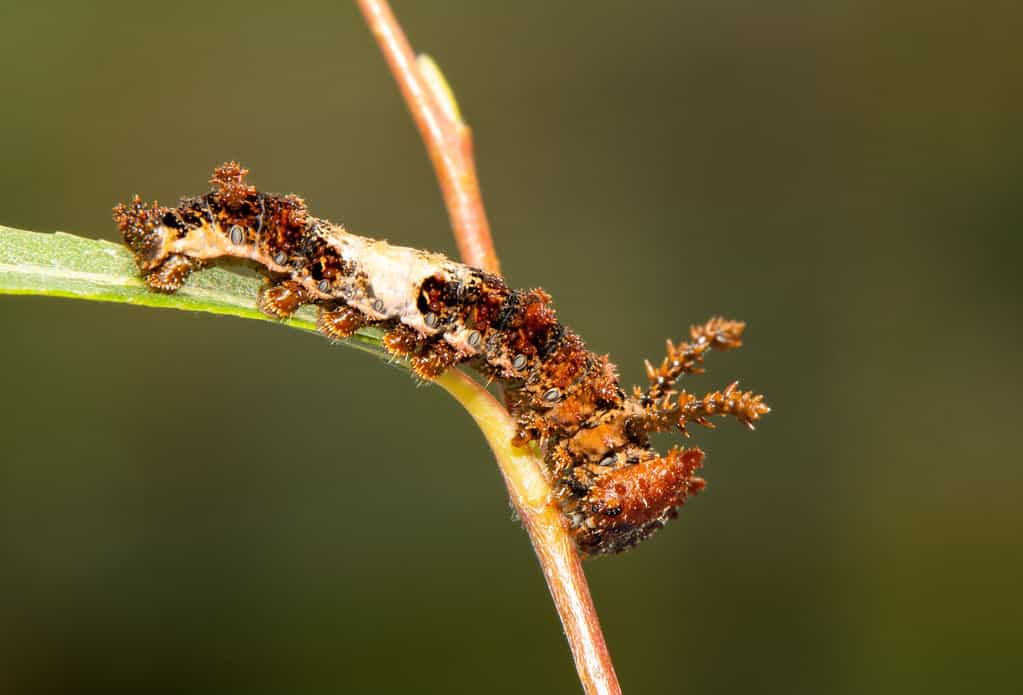
One of the most interesting-looking caterpillars in Missouri is the viceroy caterpillar.
©Sari ONeal/Shutterstock.com
The viceroy caterpillar has an appearance that mimics bird droppings throughout all its growth stages. It can be spotted in brown or green shades, adorned with cream-colored spots and two bumpy protrusions on its thorax. This caterpillar primarily eats leaves from trees belonging to the willow family, including willows, poplars, and cottonwoods.
New studies have revealed that the viceroy caterpillar carries toxins!
4. Hornworm Caterpillar (Manduca quinquemaculata)
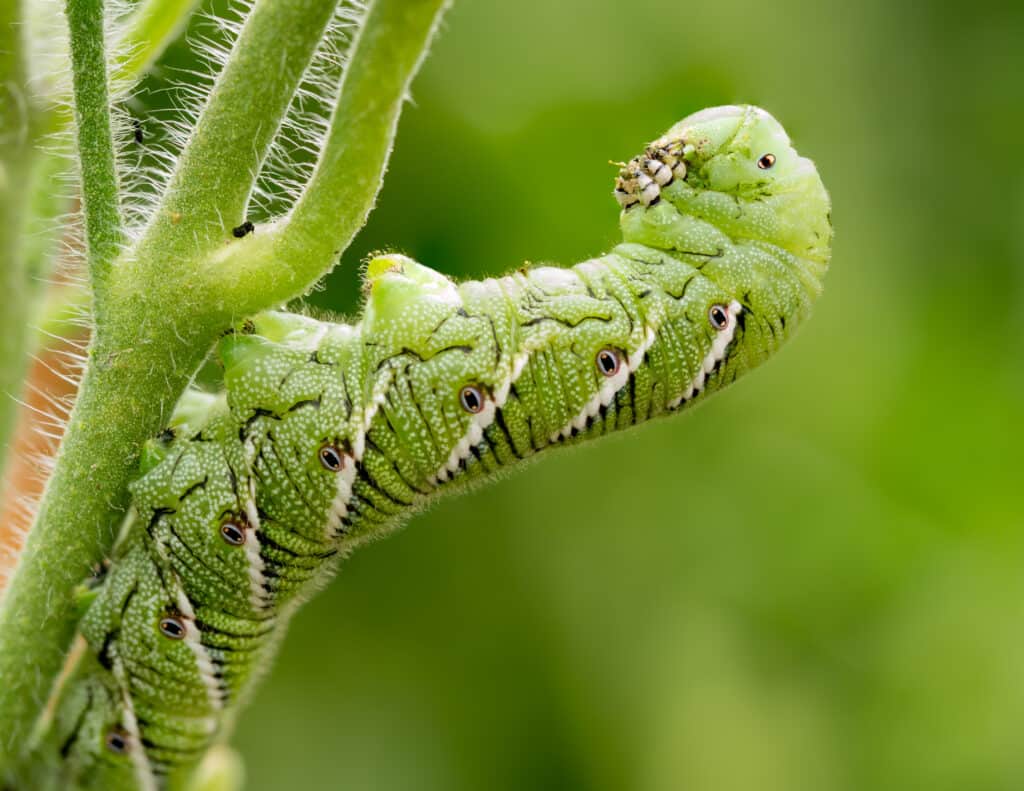
A large caterpillar, the hornworm can consume up to four times its body weight in food.
©J Gillispie/Shutterstock.com
The hornworm caterpillars are recognizable by their large size and distinct blue-green color. These caterpillars can measure up to four inches, making them easy to spot. These caterpillars have a primary diet of tomato leaves. In a single day, a hornworm caterpillar can consume up to four times its weight in leaves and fruit.
Contrary to what some might think, hornworms are safe to touch, as they neither bite nor sting, and they aren’t poisonous.
5. White Marked Tussock Moth Caterpillar (Orgyia leucostigma)

Although not poisonous, the white-marked tussock moth caterpillar can cause skin rashes if you touch one.
©Zety Akhzar/Shutterstock.com
The white-marked tussock moth caterpillar has stripes and tufts that can be white or yellow in color. A defining feature of these caterpillars includes four big tufts near the front, a bright red head, a pair of small red dots near the back, and a black stripe running down the middle of their back, flanked by a yellow stripe. Their diet mainly consists of leaves from oak trees, blueberries, and dogwood.
Though these caterpillars are not poisonous, they can cause skin rashes if touched.
6. Giant Leopard Moth Caterpillar (Hypercompe scribonia)
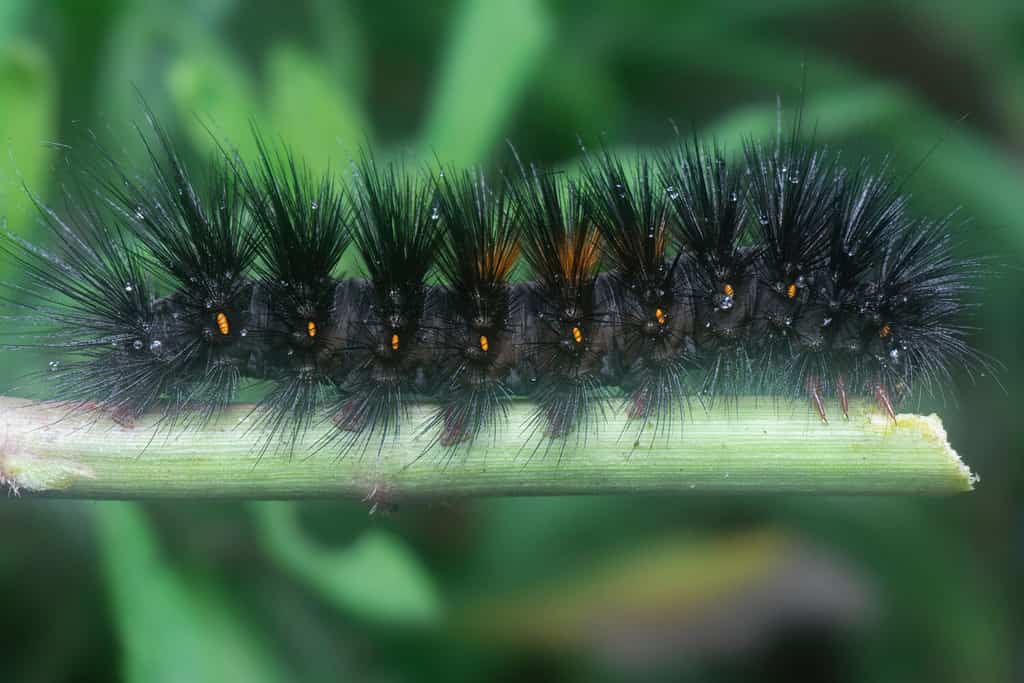
The giant
leopard
moth caterpillar can reach up to three inches in size and is covered in black bristles.
©Young Swee Ming/Shutterstock.com
The caterpillar of the giant leopard moth can reach a length of about two to three inches and is adorned with glossy black bristles. Unlike the bristles of some other hairy creatures, these do not cause irritation or discomfort since they don’t break off when touched by predators. This caterpillar has a diverse diet, enjoying leaves from a range of plants such as citrus, magnolias, lilacs, and broadleaf plantains.
Despite its striking appearance, the giant leopard moth caterpillar is not poisonous.
7. Eastern Tiger Swallowtail Caterpillar (Papilio glaucus)
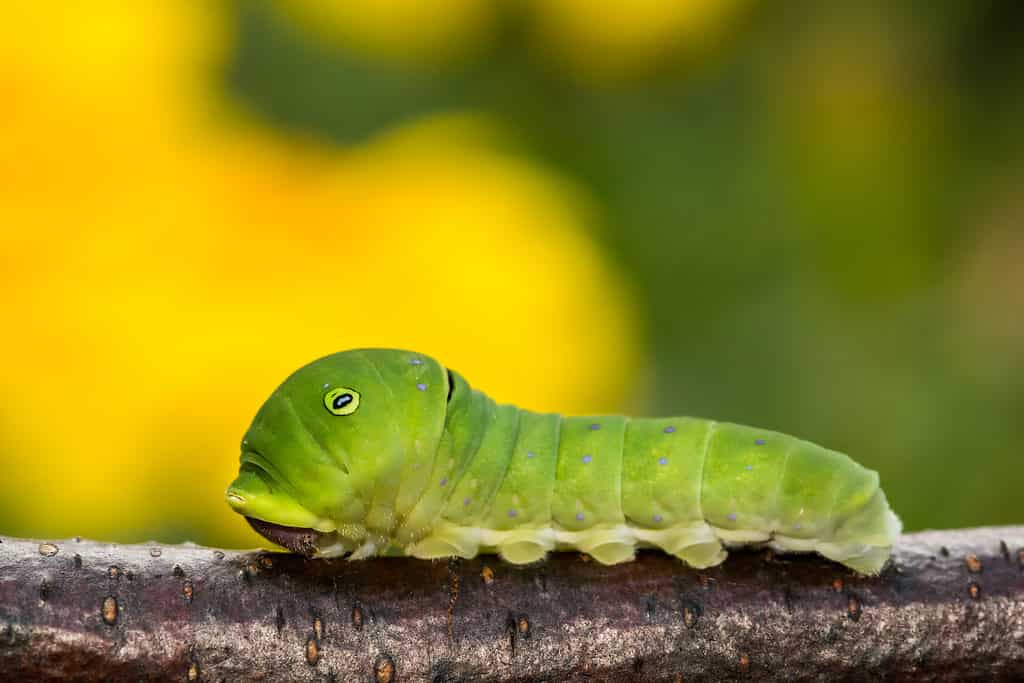
As a defense mechanism, the eastern
tiger
swallowtail caterpillar can extend a foul-smelling, orange gland.
©Jay Ondreicka/Shutterstock.com
Eastern tiger swallowtail caterpillars are notable for their bright green color and the presence of two large eyespots on the body just behind the head, making them look as though they have large eyes. If they feel threatened, they react by arching back and extending a foul-smelling, orange, forked gland that helps keep predators away. These caterpillars feed on the leaves of various woody plants such as ash, cottonwood, and willow.
Despite their defensive mechanisms, these caterpillars are not poisonous and pose no risk to humans.
8. Spicebush Swallowtail Caterpillar (Papilio troilus)
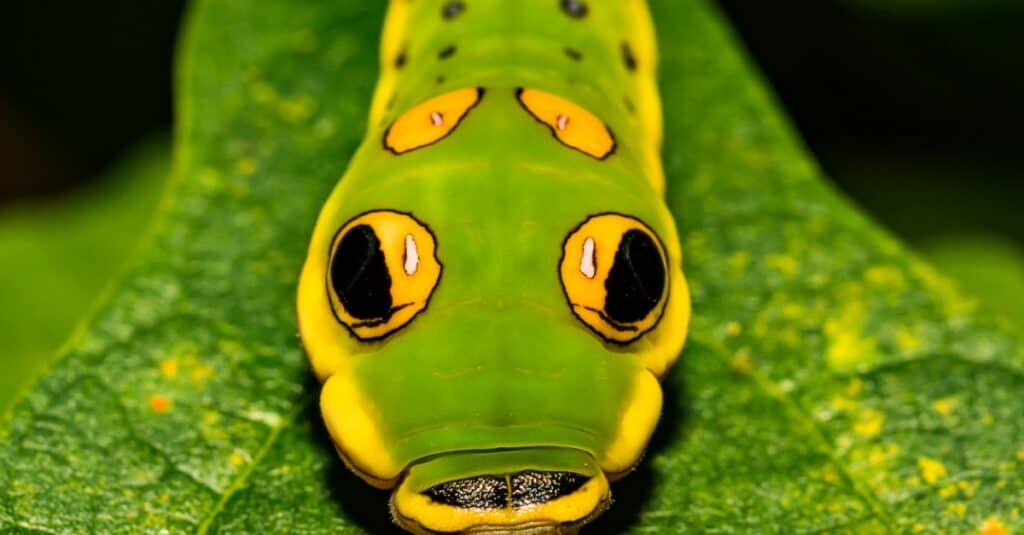
The eyespots of the spicebush swallowtail caterpillar may look intimidating, but this caterpillar is harmless.
©iStock.com/JasonOndreicka
Spicebush swallowtail caterpillars are known for their bright green, sleek appearance, highlighted by two pairs of striking black and yellow eyespots on a raised area behind the real head. The adult form of this insect is a large black butterfly, beautifully adorned with shimmering blue or green on its hindwings. These caterpillars commonly eat leaves from plants such as spicebush, sweet bay, sassafras, and tulip trees.
Despite their intimidating eyespots, spicebush swallowtail caterpillars are entirely harmless.
9. Cecropia Moth Caterpillar (Hyalophora cecropia)

The cecropia moth caterpillar can be found in Missouri.
©K Hanley CHDPhoto/Shutterstock.com
One of the largest caterpillars in Missouri, the cecropia moth caterpillar also stands out for its bright colors. These caterpillars can grow even longer than an adult’s finger, reaching up to 4.5 inches. They often display a bright or sea green hue, with noticeable bumps on their back, each tipped with a black spine. Their diet is quite diverse, including the leaves of various trees and shrubs such as alder, elm, maple, poplar, wild cherry, and plum.
Despite their intimidating appearance, the bristles on the cecropia caterpillar’s body are not harmful. Touching them is not dangerous, and they are not poisonous.
10. Monkey Slug Caterpillar (Phobetron hipparchia)
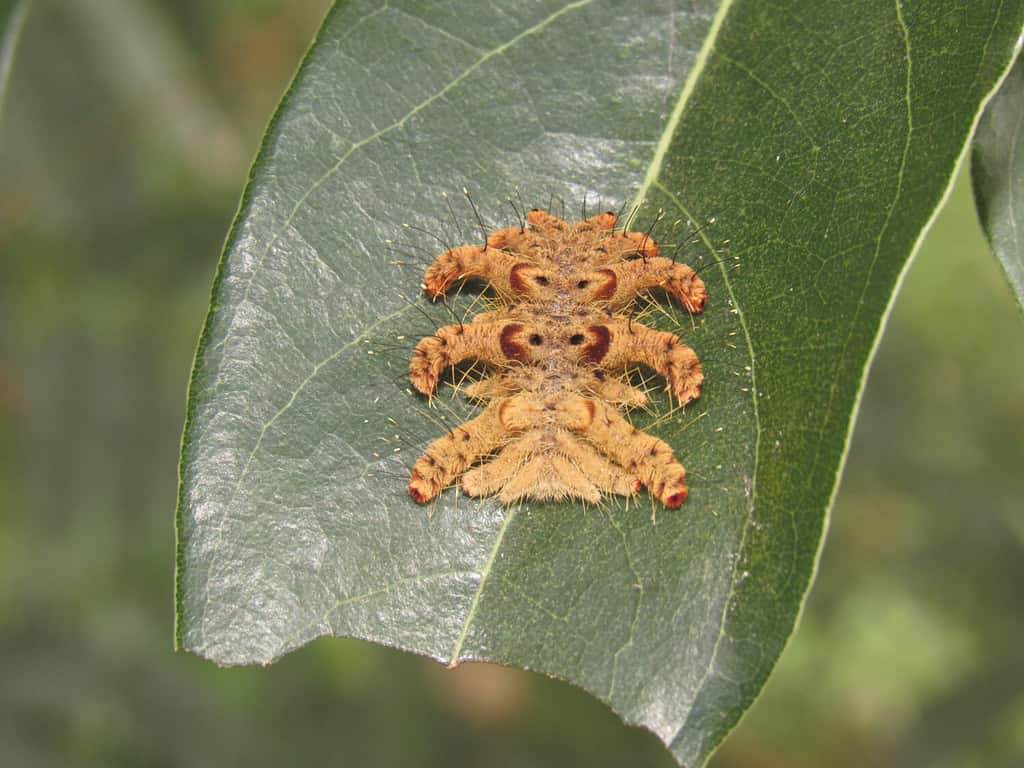
We bet you never knew a caterpillar could look like this! The monkey slug caterpillar moves around in a slug-like manner.
©Fabio Ara/Shutterstock.com
The monkey slug caterpillar resembles a fuzzy, brown starfish with a slightly elongated shape. Unlike typical caterpillars, these unique creatures have suckers instead of prolegs, allowing them to move around in a slug-like manner. Some might believe that their hairs sting, but that’s a misconception. Their diet consists of leaves from a range of deciduous trees and shrubs, including dogwood, hickory, oak, persimmon, and walnut.
Despite its odd appearance, the monkey slug caterpillar isn’t harmful.
11. Io Moth Caterpillar (Automeris io)

As they grow, io moth caterpillars turn into a yellow-green color.
©Andy Reago & Chrissy McClarren / CC BY 2.0 – License
The io moth caterpillar is reddish-brown and features six light-colored lines running along its body, with six rows of spiny protrusions. As it grows, it becomes more yellowish-green, and the longitudinal lines become lighter and more pronounced. This caterpillar has been observed eating over 30 plant species in Missouri. In particular, it’s commonly seen on sassafras plants in the Ozarks region.
Unlike some other caterpillars, the Io moth caterpillar is poisonous and can deliver a painful sting.
12. Armyworm Caterpillar (Spodoptera frugiperda)
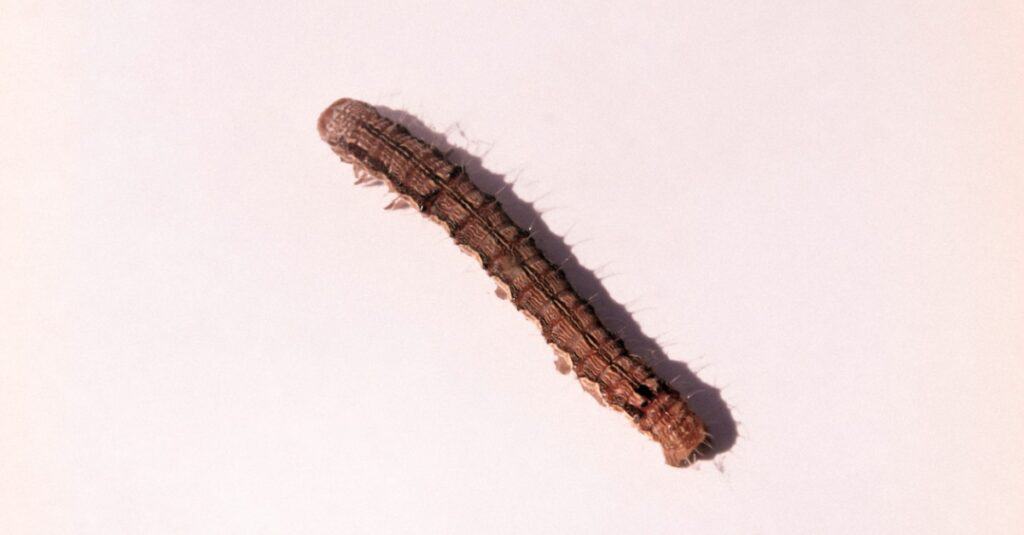
Although it starts its life as a green larva, the
armyworm
caterpillar soon turns into a brownish color.
©iStock.com/yogesh_more
The armyworm caterpillar starts its life as a light green larva, later transforming into a brownish caterpillar adorned with white and brown stripes along its sides. These stripes feature rows of half-circle black spots, particularly noticeable along the white stripe. The diet of the true armyworm moth’s larvae includes various grass species known as Gramineae and other cultivated crops, making them a common agricultural pest.
Though they can cause significant damage to plants and crops, these caterpillars are not toxic or harmful to humans.
13. Bagworm Caterpillar (Psyche casta)

To protect itself, the bagworm moth caterpillar quickly builds cocoons.
©TRR/Shutterstock.com
Bagworm moth caterpillars are usually light yellow, adorned with black patterns, and they grow to a length of up to 1.5 inches. Having six jointed legs like other insects, they quickly build cocoons after emerging from their eggs. These caterpillars consume various things, including lichens, grasses, and the foliage of conifers and shrubs.
While not toxic to humans, bagworms can be harmful to plants.
14. Black Cutworm Caterpillar (Agrotis ipsilon)
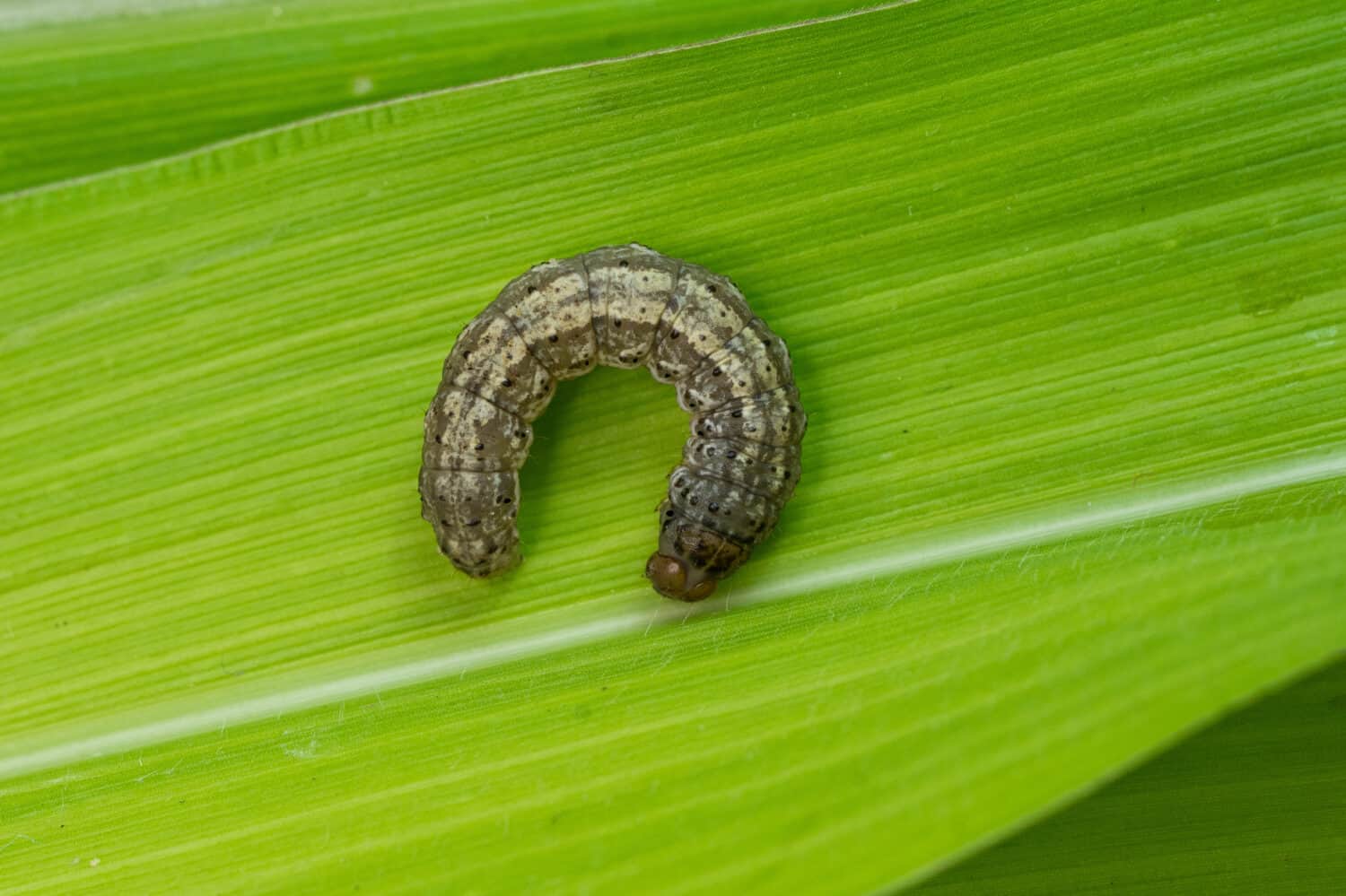
Growing up to 2 inches in size, the black cutworm caterpillar ranges in color from light gray to black.
©Maurien trabbold/Shutterstock.com
Black cutworm larvae can be as small as 1/8 inch when they’ve just hatched, growing to 2 inches when fully matured. Their color ranges from light gray to almost black, and their skin has a greasy look with coarse granules of different sizes. These cutworms have a broad diet and feed on almost all types of vegetables and many significant grains, with corn being a particular favorite.
Though they aren’t poisonous, black cutworms are known to cause severe damage to crops in Missouri.
15. Spiny Oak Slug Caterpillar (Euclea delphinii)
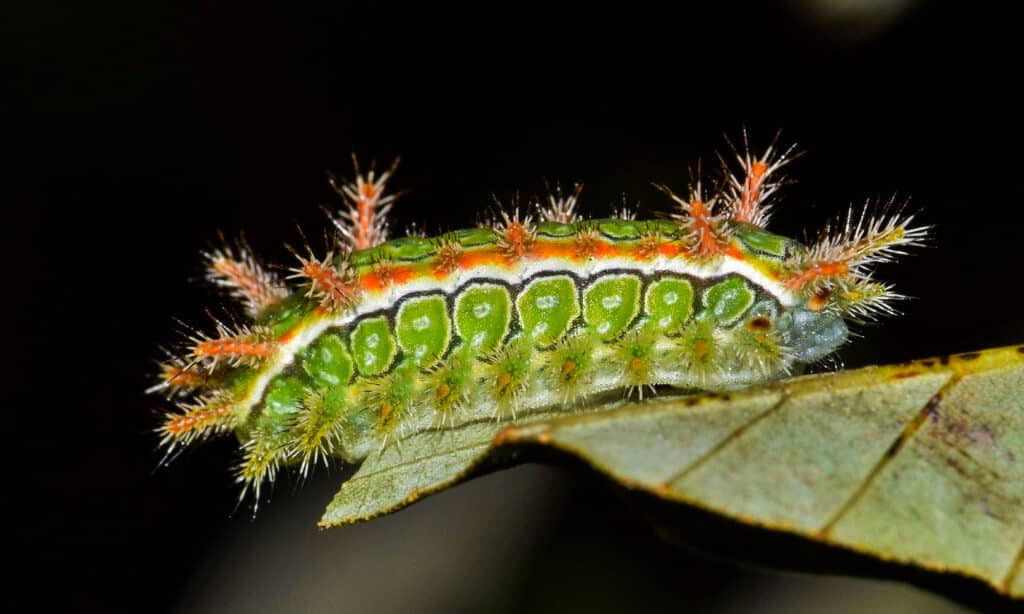
A colorful caterpillar, the spiny oak slug caterpillar comes in shades of green, yellow, orange, and red.
©iStock.com/Brett_Hondow
These caterpillars resemble slugs and come in shades of green, yellow, orange, or red. They’re characterized by three pairs of large, horn-like spines with dark-tipped bristles at the front and two more similar spines at the back. Their diet is quite varied, and they consume the leaves of different trees, such as oaks, apples, plums, and others.
Though the spines of these spiny oak-slug caterpillars contain toxins, their stings are considered to be milder.
16. Stinging Rose Caterpillar (Parasa indetermina)
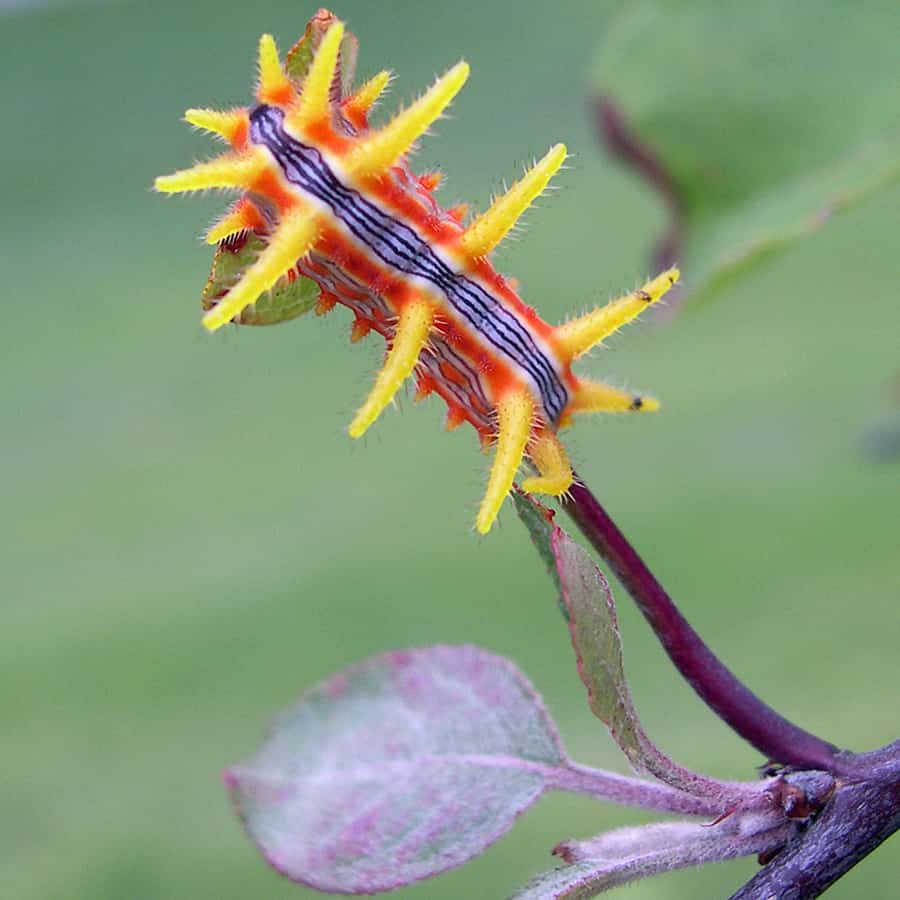
Coming in many colors, the stinging rose caterpillar is quite beautiful.
©M. Whitson / CC BY 4.0 – License
The stinging rose caterpillar displays an array of colors, from yellow to red, and is adorned with black and blue stripes running down its back. Along its sides, you’ll find more subtle red, blue, and black stripes. This caterpillar feeds on apple trees, oaks, poplars, and rose bushes.
One must be careful when encountering this caterpillar, as its spines can break off upon contact with human skin, releasing a toxic fluid. This interaction often results in a painful sting.
17. Pipevine Swallowtail Caterpillar (Battus philenor)

Both adult and caterpillar stages of the pipevine swallowtail are poisonous.
©Sundry Photography/Shutterstock.com
The pipevine swallowtail caterpillar is notable for its dark reddish-purple color and soft, protruding features, especially around the head and tail segments. Because of its unpleasant-tasting body fluids, most predators tend to avoid it. Interestingly, other butterflies mimic its appearance to enjoy the same protection. This caterpillar has a specialized diet, feeding exclusively on the leaves of plants like birthworts and Dutchman’s pipes.
A unique characteristic of the pipevine swallowtail is that both the adult and the caterpillar stages are poisonous.
18. Puss Caterpillar (Megalopyge opercularis)

The furry appearance of the puss caterpillar might look inviting, but it is incredibly poisonous.
©Chase D’animulls/Shutterstock.com
The puss caterpillar, reaching about an inch in length, has a distinctive furry appearance. Its body is fully cloaked in thick tan or grayish-white hairs that narrow towards its rear. Feeding mostly on leaves from trees such as poplar, sallow, and willow, this caterpillar is commonly found in places like woodlands, parks, or even household gardens.
While it may look soft and harmless, the puss caterpillar is actually the most poisonous of its kind in the United States. Concealed among its hairs are hollow spines that contain a potent poison, making it a creature to be wary of.
19. Saddleback Caterpillar (Acharia stimulea)
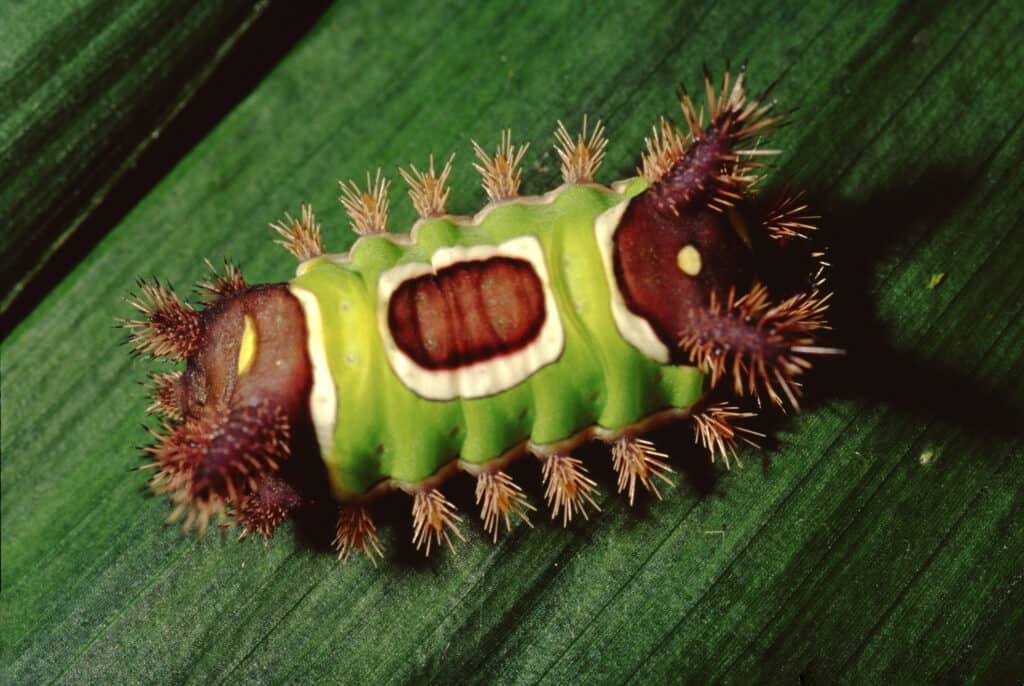
With its distinctive green back, the saddleback caterpillar is also dangerous.
©Liz Weber/Shutterstock.com
Saddleback caterpillars have distinctive green backs, marked with a central brown dot encircled by white. Both ends of the caterpillar are brown, and the skin appears granulated, adorned with pairs of fleshy horns. In the larvae stage, this caterpillar has a slug-like body and grows to a length of one inch. These caterpillars have a diverse diet and are known to feed on the leaves of various plants such as sunflowers, dogwoods, gladiolas, and others.
Though not as venomous as the puss caterpillar, the saddleback caterpillar is still dangerous. Its body is covered in hairs that can release irritating venom. Being mindful around this caterpillar is advised, as it can cause discomfort if touched.
20. Eastern Tent Caterpillar (Malacosoma americanum)
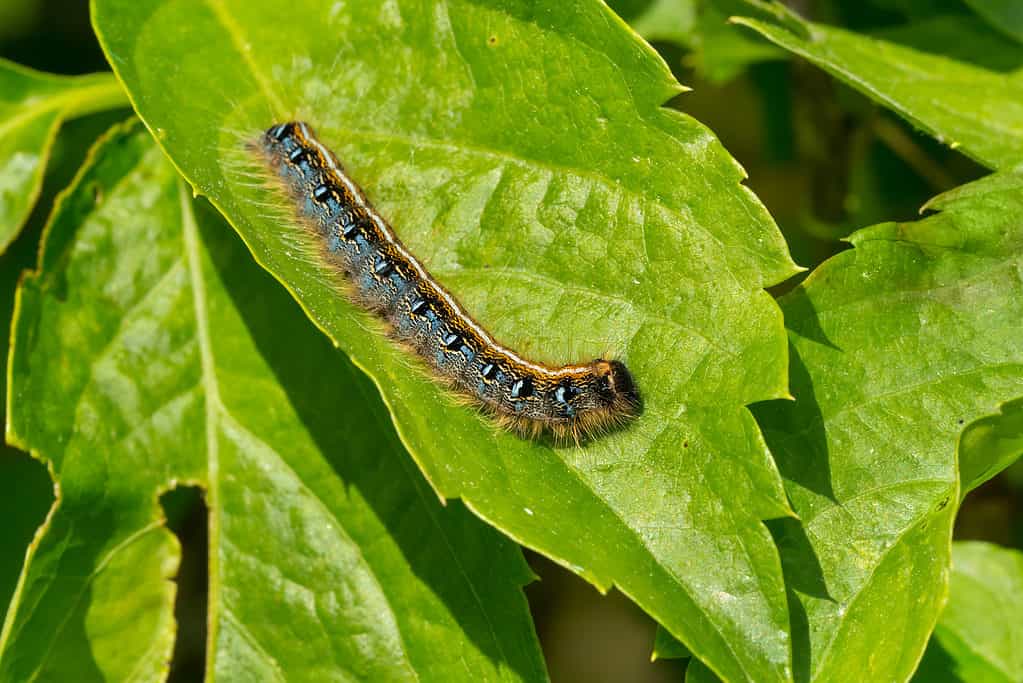
With blue, black, and orange markings, the eastern tent caterpillar grows up to 2 inches long.
©Paul Reeves Photography/Shutterstock.com
Eastern tent caterpillars have a hairy appearance and are adorned with blue, black, and orange markings. A distinctive white stripe runs down their back. Mostly smooth, they also exhibit a series of protruding hairs along their sides, and they reach a full length of two inches when fully matured. These caterpillars have a preference for feeding on wild cherry, apple, and crabapple trees, but they will also consume oak, poplar, cherry, peach, and plum leaves. Notably, they build tent-like structures in the forks of branches or tree trunks, venturing out from these shelters to eat.
Despite their potentially alarming appearance, eastern tent caterpillars pose no threat to humans or pets.
Regions in Missouri With the Most Caterpillars
Caterpillars are quite common in various regions of Missouri, thriving in areas rich in vegetation where they can find ample food. Some of the regions in Missouri with the most caterpillars include:
- Ozark Mountains: Rich in forests and diverse vegetation, providing ample food sources.
- Missouri River Valley: Fertile land with a variety of plants that caterpillars feed on.
- Mark Twain National Forest: A large forest area with a favorable climate and conservation efforts that support a thriving caterpillar population.
- City Parks: Planted with various trees and flowering plants, city parks create mini-habitats for caterpillars right within urban areas.
Summary of 20 Caterpillars Found in Missouri
| Number | Caterpillar | Type of Caterpillar | Poisonous/Venomous? |
|---|---|---|---|
| 1 | Monarch Caterpillar | Butterfly | Yes |
| 2 | Woolly Bear Caterpillar | Moth | No |
| 3 | Viceroy Caterpillar | Butterfly | Yes |
| 4 | Hornworm Caterpillar | Moth | No |
| 5 | White Marked Tussock Moth Caterpillar | Moth | No |
| 6 | Giant Leopard Moth Caterpillar | Moth | No |
| 7 | Eastern Tiger Swallowtail Caterpillar | Butterfly | No |
| 8 | Spicebush Swallowtail Caterpillar | Butterfly | No |
| 9 | Cecropia Moth Caterpillar | Moth | No |
| 10 | Monkey Slug Caterpillar | Moth | No |
| 11 | Io Moth Caterpillar | Moth | Yes |
| 12 | Armyworm Caterpillar | Moth | No |
| 13 | Bagworm Caterpillar | Moth | No |
| 14 | Black Cutworm Caterpillar | Moth | No |
| 15 | Spiny Oak Slug Caterpillar | Moth | Yes |
| 16 | Stinging Rose Caterpillar | Moth | Yes |
| 17 | Pipevine Swallowtail Caterpillar | Butterfly | Yes |
| 18 | Puss Caterpillar | Moth | Yes |
| 19 | Saddleback Caterpillar | Moth | Yes |
| 20 | Eastern Tent Caterpillar | Moth | No |
The photo featured at the top of this post is © K Hanley CHDPhoto/Shutterstock.com
Thank you for reading! Have some feedback for us? Contact the AZ Animals editorial team.






